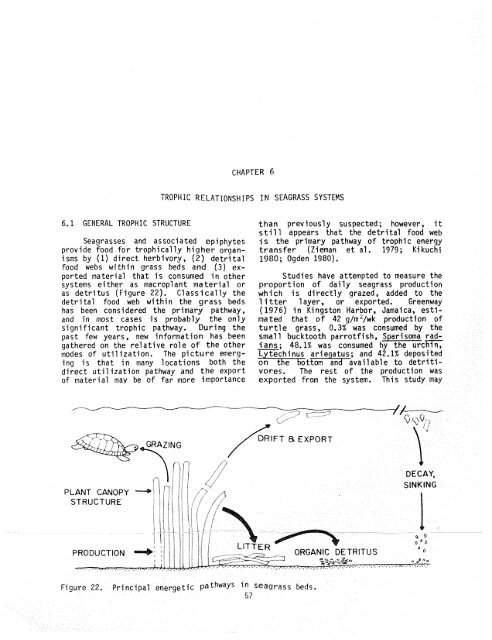The Ecology of the Seagrasses of South Florida - USGS National ...
The Ecology of the Seagrasses of South Florida - USGS National ...
The Ecology of the Seagrasses of South Florida - USGS National ...
You also want an ePaper? Increase the reach of your titles
YUMPU automatically turns print PDFs into web optimized ePapers that Google loves.
CHAPTER 6<br />
TROPHIC RELATIONSHIPS<br />
IN SEAGRASS SYSTEMS<br />
6.1 GENERAL TROPHIC STRUCTURE than previously suspected; however, it<br />
still appears that <strong>the</strong> detrital food web<br />
<strong>Seagrasses</strong> and associated epiphytes is <strong>the</strong> primary pathway <strong>of</strong> trophic energy<br />
provide food for trophically higher organ- transfer (Zieman et al. 1979; Kikuchi<br />
isms by (I) direct herbivory, (2) detrital 1988; Ogden 1980).<br />
food webs within grass beds and (3) exported<br />
material that is consumed in o<strong>the</strong>r Stud1 es have attempted to measure <strong>the</strong><br />
systems ei<strong>the</strong>r as macropl ant material or proportion <strong>of</strong> daily seagrass production<br />
as detritus (Figure 22). Classically <strong>the</strong> which is directly grazed, added to <strong>the</strong><br />
detrital food web within <strong>the</strong> grass beds 1 i tter layer, or exported. Greenway<br />
has been considered <strong>the</strong> primary pathway, (1976) in Kingston Harbor, Jamaica, estfand<br />
in most cases is probably <strong>the</strong> only mated that <strong>of</strong> 42 g/mL/wk production <strong>of</strong><br />
significant trophic pathway. During <strong>the</strong> turtle grass, 0.3% was consumed by <strong>the</strong><br />
past few years, new information has been small bucktooth parrotfish, Sparisoma radga<strong>the</strong>red<br />
on <strong>the</strong> relative role <strong>of</strong> <strong>the</strong> o<strong>the</strong>r ians; 48.1% was consumed by <strong>the</strong> urcK<br />
modes <strong>of</strong> utilization. <strong>The</strong> picture marg- -chinus ariegatus; and 42.1% deposited<br />
ing is that in many locations both <strong>the</strong> %<br />
on t e ottom and available to detritidirect<br />
utilization pathway and <strong>the</strong> export vores. <strong>The</strong> rest <strong>of</strong> <strong>the</strong> production was<br />
<strong>of</strong> material may be <strong>of</strong> far more importance exported from <strong>the</strong> system. This study may<br />
/-- -"#----'---- .-------.<br />
-<br />
i"<br />
LP'~<br />
DRIFT €3,<br />
EXPORT<br />
DECAY,<br />
PLANT CANOPY 4<br />
STRUCTURE<br />
PRODUCTION<br />
Figure 22.<br />
.. .<br />
Principal energetic pathways in seagrass beds.<br />
5 7

















